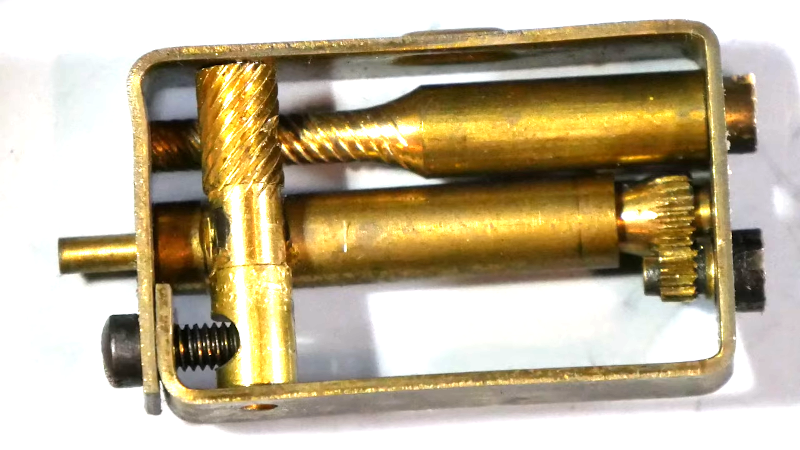We didn’t know what a C-2400 LP was before we saw [David’s] video below, but it turned out to be pretty interesting. The device is an aircraft compass and after replacing it, he decided to take it apart for us. Turns out, that like a nautical compass, these devices need adjustment for all the metal around them. But while a ship’s compass has huge steel balls for that purpose, the tiny and lightweight aviation compass has to be a bit more parsimonious.
The little device that stands in for a binnacle’s compensators — often called Kelvin’s balls — is almost like a mechanical watch. Tiny gears and ratchets, all in brass. Apparently, the device is pretty reliable since the date on this one is 1966.
The brass compensation device was stripped, but you can still buy the unit for about $80, so it was possible to repair the device. [Dave], however, put a more modern compass in his cockpit. Of course, these days you don’t actually need a floating magnet to make a compass.
Turns out, the Earth’s magnetic field isn’t a stationary target, and — eventually — the poles are going to flip again, or at least that’s what scientists say. These days you can get a compass with other instruments all in one little package.
















Of course, these days you don’t actually need a floating magnet to make a compass.
Aircraft still need magnetic compasses that do not require power to operate. The regulations:
No person shall conduct a take-off in a power-driven aircraft for the purpose of day VFR flight unless it is equipped with
[…]
(d) a magnetic compass or a magnetic direction indicator that operates independently of the aircraft electrical generating system;
Seems to leave plenty of room for a magnetic field sensing compass that operates on a battery.
The ships compasses with the huge steel balls are pretty ancient as well.. Nice on large old skool sailing ships etc..
Magnetic compasses have to be hand calibrated every x years (depending on use and local laws) with tiny calibration pieces inside the compass housing itself.
Most commercial vessels will opt for an electronic compass which can self calibrate by doing a few loops while in calibration mode. (without passengers, my experience is that they dont like the loops very much)’
for smaller (non commercial) sailing ships you either use a magnetic compass without bothering with the calibration that much. Some still make a deviation table tot account for the error introduced by the metal engine etc. on various courses. Then again, the errors on those are a maximum of -2 till +2 degrees for most ships. Those can be ignored for manually steered sailing ships, most sailors are glad if they can keep course at a max of 5-10 degrees from intended course :-)
For the more electronically inclined (read those with more money to send on their sailing hobby), a fluxgate compass is the thing to use. This will pretty much correct for all errors. (except for the little metal weight attached to the wash basin plug of the toilet swinging around on it’s little chain just above the fluxgate itself.. Owner found it a very handy place to reatch it)
I’m kind of surprised ships would still be going off magnetic compasses for primary navigation.
Is it really superior to GPS in any way?
The potential cost of going in the wrong direction for a large ship can be pretty dire. Commercial ships do not primarily steer off of a magnetic compass, they use an electric gyro compass. But power issues can throw off the gyro or GPS, and the helmsman is trained to be able to immediately be able to switch to magnetic heading. There will be a several GPS units, with their antennas mounted in different places. All of these devices are regularly checked against each other, because any system can fail. The magnetic compass is extraordinarily unlikely to fail, and a navigator is trained to be able to apply compass corrections to find what magnetic heading to follow in order to follow a true course.
When you navigate a ship, you never want to rely on a single source for your information. The more methods you use to check, the better off you are. Besides the compasses, you use known objects like lighthouses. When you pass one, you figure out what range and bearing it should be at if your navigation is correct, and you check it with the compass and radar to make sure. You do the same thing with depth in shallow water. If the chart say there is 100′ of water here, and there is only 60′, something is probably wrong.
But as to the compass, it is normal to check the magnetic vs the gyro heading several times each hour, and write both on a little blackboard. Sometimes the first sign that you have a problem with the electronic systems is when the helmsman checks the magnetic compass, notices it is reading an unexpected heading, and thinks “well that is odd”.
Sorry, alcohol compass was indeed used at one time. However, now it’s a kerosene type fluid.
https://www.aviationconsumer.com/maintenance/magnetic-compass-upkeep-more-than-fluid-fills/